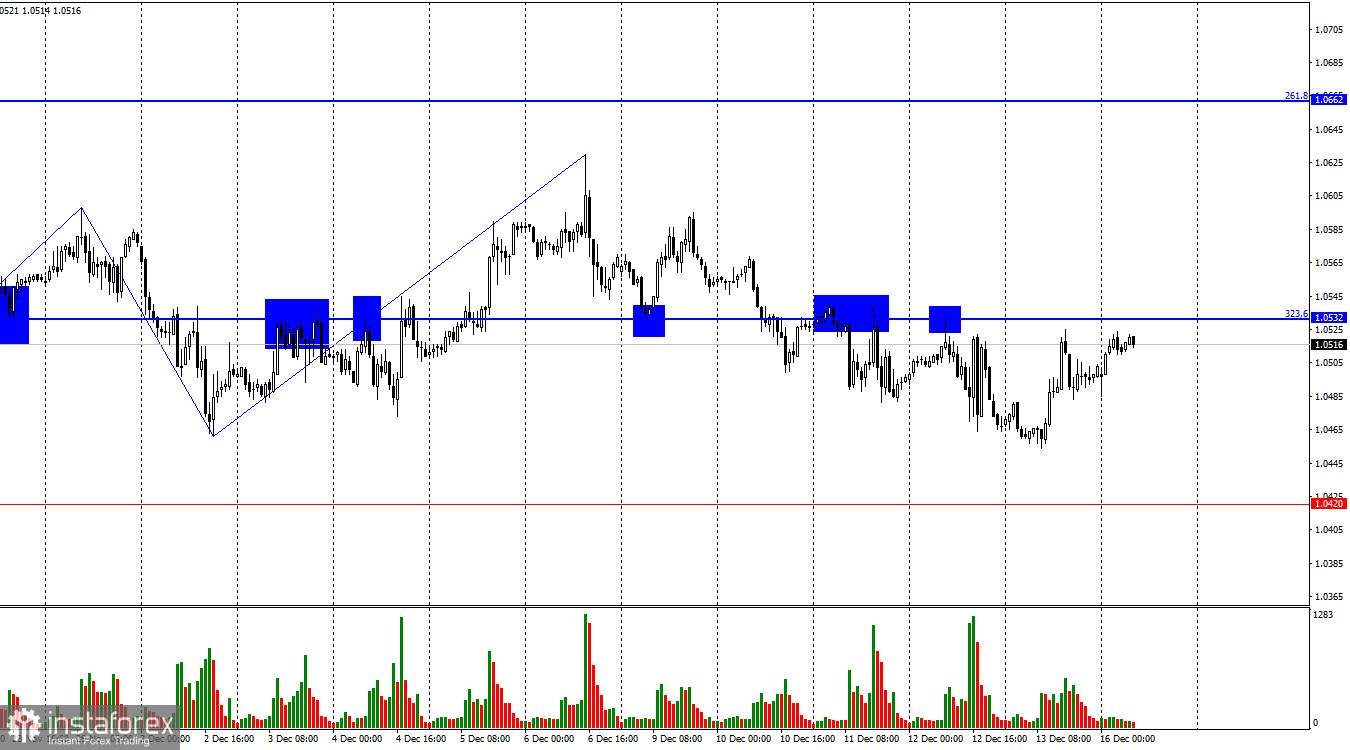
The wave structure is simple and clear. The last completed downward wave did not break the previous low, while the last upward wave marginally broke the previous peak. This indicates the formation of a "bullish" trend, although it appears weak and may already have concluded. For the current "bullish" trend to break, the pair must fall below the 1.0461 level.
On Friday, the fundamental data was relatively weak, yet the bulls managed to take the initiative. It's unlikely that the industrial production report from the Eurozone contributed significantly. Production volumes in October remained flat (0% m/m), which was slightly better than the anticipated small decline. However, a zero growth rate cannot truly be considered positive. The euro might have shown some gains on this data, but the grounds for such growth seem questionable.
The day before, the ECB decided to cut interest rates by 0.25%, and ECB President Christine Lagarde spoke about economic weakness, slowing growth, and the need for continued monetary policy easing. This combination of factors does not favor euro growth. Thus, the euro's best hope currently is for minor increases supported by positive Eurozone data or negative US data. Below the 1.0532 level, bearish sentiment remains dominant on Monday, and I am looking for opportunities to open new short positions.

On the 4-hour chart, the pair has rejected the 100.0% Fibonacci retracement level at 1.0603 for the second time and continues to decline toward the 127.2% level at 1.0436. The "bearish" divergence on the CCI indicator supports further downward movement. A rebound from the 1.0436 level could signal a slight upward correction, but a close below this level would increase the likelihood of further declines toward the 161.8% Fibonacci level at 1.0225.
Commitments of Traders (COT) Report

During the latest reporting week, speculators closed 10,318 long positions and opened 7,766 short positions. The sentiment of the "Non-commercial" group remains "bearish" and is strengthening, signaling further declines for the pair. The total number of long positions held by speculators is now 157,000, while short positions total 233,000.
Major players have been consistently offloading the euro for 13 consecutive weeks, indicating a "bearish" trend. The main driver for a weaker dollar—expectations of Federal Reserve monetary policy easing—has already been priced in. There is little reason for markets to continue offloading the dollar, making further USD strength more likely. Technical analysis also points to the onset of a long-term "bearish" trend, supporting expectations for an extended decline in EUR/USD.
Economic Calendar for the Eurozone and US
- Eurozone: ECB President Christine Lagarde speaks (07:00 UTC)
- Germany: Services PMI (08:30 UTC)
- Germany: Manufacturing PMI (08:30 UTC)
- Eurozone: Services PMI (09:00 UTC)
- Eurozone: Manufacturing PMI (09:00 UTC)
- US: Services PMI (14:45 UTC)
- US: Manufacturing PMI (14:45 UTC)
The economic calendar for December 16 contains several notable releases. The impact of this data on market sentiment is expected to be moderate.
Forecast and Trading Recommendations for EUR/USD
Short positions could have been opened after the rejection from the 4-hour chart's 1.0603 level, targeting 1.0420 and 1.0320. These positions can still be held. Today, selling opportunities arise if the pair rejects the hourly chart's 1.0532 level. Buying is only advisable if the pair closes above 1.0532 on the hourly chart, but I would approach such positions cautiously at this time.
Fibonacci Levels:
- Hourly Chart: 1.1003–1.1214
- 4-Hour Chart: 1.0603–1.1214





















